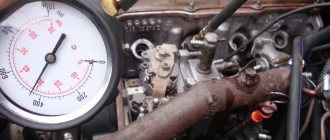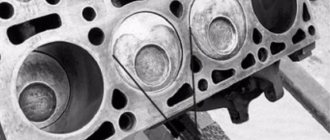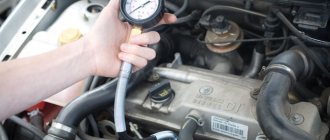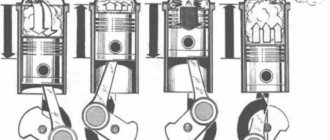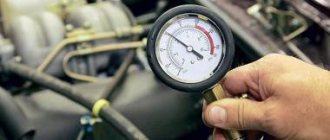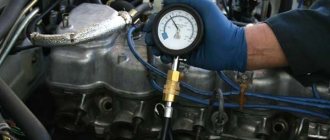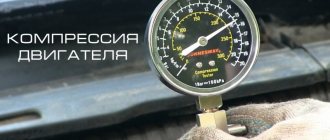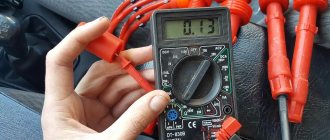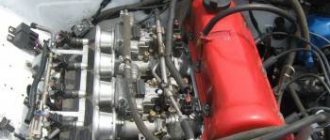When certain malfunctions occur, an experienced car owner begins to understand that the problem lies in the engine. To begin diagnosing the engine, it is necessary to measure its compression. It is necessary to measure compression if the engine is consuming excessive oil, as well as if the car slowly picks up speed or stalls frequently. The loss of engine power is immediately felt when driving, which means it’s time to measure engine compression.
Compression refers to the highest air pressure in the cylinder when the engine is idling. This pressure is measured in turn in each subsequent cylinder, and the readings must be equal to the standards established by the manufacturer. With these values, you can more accurately determine what the problem is with your car's engine and thus fix it.
Differences between compression and compression ratio
These two concepts are different from each other, although their meanings are somewhat similar. The compression ratio is calculated as follows: when the piston reaches top dead center (the end point of its operating range), a combustion cell with volume V1 is located above it. With the movement of the piston to the bottom dead center, the volume of the piston V2 is added to the volume V1.
The compression ratio is calculated using the formula V2 divided by V1. This indicator is noted by the machine manufacturer in the technical manual, for example, 10 or 14. This means that the combustible mixture is compressed 10 or 14 times.
Compression, unlike compression, is measured in atmospheres and shows the pressure at the end of compression of the mixture when the piston enters the top dead center region. The higher the compression ratio, the more power the car has. Powerful compression will ensure efficient combustion of fuel. However, increasing the compression rate to the maximum is dangerous: the fuel may start to ignite randomly, which will lead to engine damage. Typically the compression ratio is higher than the compression ratio. With a compression of 9.4, the compression can be 11-12 kg/sq.m. cm.
Video 10:00 minutes. What is the difference between compression ratio and compression?
Why is compression measured?
Everything is known and understandable, but still, you need to think about this question: why measure compression at all? Yes, primarily for diagnosing the engine and its condition. But in fact, by measuring the compression, other conclusions can be drawn:
- Alternatively, this is a determination of the technical condition of the CPG (cylinder-piston group) and, of course, the condition of the valves. However, we can say that this is practically useless, because this very condition is influenced by a huge number of factors:
- Exhaust resistance and exhaust airflow resistance
- Valve distribution phases, their relationships.
- Crankshaft rotation speed.
- Changes in air leaks in the cylinder-piston group.
- Simply measure compression to get real-world engine performance results. All or some of the above conditions will occur to varying degrees at low compression.
- The higher the compression, the lower the temperature at which the engine can start without any problems. At low temperatures, the gas decreases in volume, and accordingly the compression becomes even lower. Therefore, you should once again make sure that everything is in order with the compression. It is better if it is in medium values, since with high compression there is a risk of damaging the engine, and with low compression it will simply be impossible to start the engine in winter.
How often to measure the compression ratio
Vehicle manufacturers do not provide accurate data on the timing of checking the compression ratio. There are symptoms that indicate the urgency of such testing:
- One or more cylinders are not functioning properly, which leads to engine vibration.
- Oil consumption has increased significantly.
- Engine power has decreased.
- Blue or whitish smoke comes out of the exhaust.
- Problems starting when cold.
You can measure the pressure in the cylinders together when replacing spark plugs every 20-50 thousand km. mileage This way you will protect yourself from possible problems with the engine in advance.
It may be interesting: What is the best way to inflate a tire?
Reasons for decreased compression
Typically, a decrease in compression occurs due to wear and tear of the vehicle. You can increase the service life of a car if you understand why this decrease occurs.
Reasons for low compression:
- After repair work, the marks on the gas distribution phases were displaced.
- Burnout or hole in the cylinder head gasket.
- Valve springs are faulty.
- Camshaft cam malfunction.
- Wear of cylinders or rings.
- Piston burnout, crack formation.
Factors influencing compression
The level of compression depends on the range of incoming air mass. Therefore, there is a direct correlation between poor compression and a dirty air filter. Also, the drop in compression is affected by the gaps between valves of different sizes. Depressurization of the pressure gauge and check valve pipelines has a direct impact on the compression value.
Compression testing without special instruments
Typically, compression measurements are made using a compression meter. But in its absence, you can simply find out about the presence of compression in the cylinder, in some cases this can contribute to correct diagnosis. The presence of poor compression is indicated by such signs as unproductive operation of the machine, the presence of exhaust gases with a blue tint, oil getting on the spark plugs, contamination of the ventilation unit and the fuel combustion chamber.
Hearing testing
Even novice drivers can master this basic type of compression testing. You just need to put your ear to the engine. If there is pressure in the cylinders, a clear sound will appear when the starter operates, rhythmic with compression. In general, the engine is characterized by mild staggering. If there is no compression, the ear will hear total silence, there will be no swaying or other movements. This can happen if the timing belt in the car breaks.
Testing with a compression meter
A special device - a compression meter - is needed to measure compression in the engine. It has a low price, so it is often present in the tool kit of even a novice car enthusiast. In addition to the spark plug wrench, it is better to perform this procedure with a second technician, who will regulate the operation of the starter.
Compression measurement algorithm:
- Warm up the car.
- Remove the spark plugs from their seats.
- At this time, the second master presses the pedal all the way, turning the ignition key and activating the starter.
- Insert the probe of the device into the hole of the spark plugs and, when starting the starter, take a measurement for several seconds so that the indicator stops.
- Turn off the starter and record the readings. Repeat the measurement for a more accurate result, then perform a similar operation in other cylinders.
- Before taking a new measurement, clear the device of excess air mass.
The data may deviate from the standards by plus or minus 10%. If the data does not correspond by 15% or more, we are talking about excessive wear of the engine components: cylinders, piston rings, valves. In this case, repair work is necessary.
Let's consider the main elements that are important for the compression of a diesel engine.
examination
CPG.
The compression performance of a car engine largely depends on the serviceability of the cylinder-piston group. The state of the CPG is the most important factor in determining the desired parameter. In this case, everything depends on the tightness of the engine. The better the condition of the car's engine, the less loss of air flow through joints and components. Of course, factory assembly is accompanied by fairly strict and vigilant control. When leaving the factory, the car has minimal air flow loss, but during the vehicle's operation this figure may increase. If you take two cars of the same brand, with the same mileage, the indicators will still differ. This is explained by some factors influencing the condition of the cylinder-piston group:
- Amount of load. Thus, the state of the CPG is influenced by the intensity of acceleration, average speed and driving style of the motorist.
- The quality of the working fluid used. As a rule, the use of low-quality motor oil accelerates the wear of working engine components, while a good mixture prevents aging of the CPG.
- Vehicle operating conditions. With constant startup and operation in extreme weather conditions, the CPG loses its seal due to sudden temperature changes.
There is a fairly wide list of factors that positively or negatively affect the state of the CP. The reasons being considered are very obvious and understandable to every car enthusiast. In addition, there is a factor that is known only to experienced car enthusiasts or automotive repair professionals - the dimensions of the CPG.
diesel check
Professionals have traced the proportionality of the increase in maximum mileage to the direct increase in engine dimensions. One of the characteristics that influences the engine's operating time is the size of the cylinders. Thus, we can say that the larger the engine, the longer it lasts, and the compression drops much less. Despite the fact that with large dimensions of the engine the amount of air passed through increases, when converted to a liter of volume the loss rate will be much lower than for a small engine.
This can easily be explained by the fact that even with slight wear of the CPG in small cars, compression drops sharply. As a rule, the compression of a serviceable motor is in optimal condition due to the appropriate level of rings. During operation, the rings begin to lose their roundness and allow air flow to pass through, causing the engine to lose compression. With equal mileage, the rings of large engines retain their structure longer due to their massiveness and, accordingly, maintain the required gas pressure.
Thus, we can conclude that its reliability largely depends on the massiveness of the engine and the compression level will decrease much more slowly than on an engine with small dimensions. If we consider diesel engines, then this rule becomes even more relevant, since compression plays a decisive role in the proper operation of a diesel engine.
How to measure pressure on a removed engine
The procedure is mainly needed if you are buying only the engine, often from private sellers. Such testing will help you figure out how efficient this unit is. In this case, simply starting the motor will not be enough; it is advisable that the motor be correctly installed and secured. You need to connect the wires, starter, battery and fuel pump to it.
In some cases, the gearbox is also connected if the starter starts only through it (as for front-wheel drive cars). In this case, the compression ratios will be relatively correct. For a simpler measurement, you can crank the crankshaft to TDC by connecting a pressure gauge to the engine in advance to record the data. But it is worth considering that “cold” measurements may have significant differences from the actual compression ratios.
Also read: What is an AMT transmission?
Compression measuring device
Of course, to perform these measurements there will be a necessary tool, in this case it is a simple device that mainly consists of a barometer.
A similar barometer is also used in compressors, for inflating tire pressure, or in individual devices called the same name, barometers. But one caveat should be made: the compression gauge is designed for higher pressure.
A compression gauge is a simple design that basically consists of a pressure gauge. It, in turn, is connected to an adapter, which has the same thread bored as on a standard spark plug and has a similar appearance.
It was also said above that there is another device called a compressograph. The differences, as mentioned, are minimal, but the price advantage still remains with the first option. Although convenience can offset material costs.
Also, the price depends on many other factors that are also worth paying attention to. And the first and probably the most important factor is quality. Yes, even the cheapest product can be of high quality, but it is better to take something in the middle price category. And preferably from a trusted brand manufacturer.
Compression measurements on gasoline and diesel engines
Measuring engine compression in a variety of ways will make it possible to determine the problem of an existing malfunction. It is not at all necessary to go to the station for this; you can carry out the measurements on your own. To do this you will need the following tools:
- compression meter - the main device for measuring compression;
- car battery, fully charged;
- key for candles;
- starter is in working order.
Gasoline engine measurement
If you are new to such measurements, the best solution is to warm up the engine. You can then disconnect the low voltage cords and air filter. The compression gauge is a standard pressure gauge with a special probe. The design enters the spark plug container and measures the pressure in the cylinders one by one, while the engine runs idle.
You need to hold the construct for ten seconds and pull it out when the pointer stops. Optimally, you need to take 2-3 measurements and calculate the average number. It is considered normal if the indicators differ from those indicated in the technical data sheet, since as the machine wears out over time, compression can decrease by 10 percent or more. For a gasoline engine, such fluctuations are more acceptable than for a diesel engine.
Measurements on a diesel engine
Compression measurements for diesel engines are carried out to record the correct functioning of a cooled engine. The measurement interval on the device must be at least 60 atmospheres.
Algorithm for measurements on a diesel engine:
- the nozzle is unscrewed, the power is turned off;
- the only working mechanisms left are the starter and the battery;
- it is necessary to control that when measuring the crankshaft performs 200-250 revolutions per minute;
- the fuel supply valve is disconnected from the power supply;
- the compression gauge goes into the nozzle well;
- the assistant must press the pedal and activate the starter;
- Note the received data and compare it with the standards in the car’s passport.
The data varies for different brands of cars and ranges from 28 to 40 kg/sq.cm. Compression values may vary when measured at different ambient temperatures. A decrease in compression on a diesel engine provokes incomplete processing of the fuel mass and is fraught with the formation of bluish smoke from the muffler pipeline. The lack of power in the car will also be very noticeable.
Video 15:00 minutes. How to measure diesel compression
How is verification carried out?
compressograph
Diesel compression is the main indicator that allows you to determine the condition of the most important components of the engine system. To identify the condition, each engine has optimal compression indicators compiled taking into account its main features. If during the test a drop in engine compression was detected, this is a strong argument for professional diagnostics of your car. In such a situation, you may need high-quality repairs to restore the function of the car. Therefore, it is necessary to understand how to determine compression readings in the engine. For a successful check, it is necessary to take into account certain subtleties during the work.
Let's look at the relatively simple but really important rules that compression testing requires:
- Determining compression on a diesel engine, possibly through the spark plug channels.
- Compression can be detected by maintaining the thermal characteristics of the engine. It will not be possible to check the compression of a diesel engine with insufficient heating, since the indicators will be underestimated due to insufficient expansion of the working fluid.
- Real test results can only be obtained with the throttle fully open. If the damper is not fully open, the readings will be incorrect.
- Before checking, you must make sure that the starter is in full working order and the battery is properly charged.
- The check involves completely removing the glow plugs from each working cylinder.
To carry out this operation, you will need one of the two above-mentioned devices (compressometer or compressograph). A compression gauge looks a little different from a pressure gauge. To check, you need to remove the spark plugs and install the device conductors in their position. Next, you need to fully open the throttle and turn the key in the ignition. After the starter turns the crankshaft a couple of times, you need to pay attention to the readings of the measuring device. So, it is necessary to check each cylinder. By checking each cylinder, you can determine the general condition of the CPG. If the compression is normal, then your engine is in completely good condition. In the event of a slight change in compression, you can try to restore engine function using special additives. In case of a significant deviation from the norm, you need to contact professionals; your engine may need to be given due attention.
Thus, we learned how to check the compression in the engine. It is necessary to understand that this parameter is fundamental for a diesel engine. Therefore, to maintain the engine in good condition, check it at least once a month. Good luck with your test results!
Cold engine measurements
This option is suitable if launching is problematic. Compression in the cylinders of a cooled engine can be half the standard values due to severe wear of the cylinders and pistons (6-7 kg/sq. cm). However, after some time from the moment of starting and warming up the engine well, the pressure will increase by 3-5 divisions.
If such growth is not observed, we can clearly conclude that your car needs major engine repair work. Therefore, for a more accurate measurement, carry out two options for testing the pressure: on a warm and cooled engine.
Hot engine measurement options
There are several types of measuring compression on a warm engine; sometimes drivers use the technique of combining these methods to obtain more accurate data.
Measurements with open throttle
It is more convenient to carry out measurements with the damper open with an assistant who will depress the pedal. Low readings for this measurement will indicate loose valves, defects or wear on the camshaft cam, or a leaky cylinder head gasket.
Read: How does ABS work on a car?
How to check engine compression
Measure compression by observing the following rules: - the engine must be “warm” (60-80 degrees for the oil to have “working” fluidity); — the fuel supply should be turned off. You can, for example, turn off the fuel pump, injectors, or use other methods to prevent large amounts of fuel from entering the cylinders (so that the oil wedge does not erode); - You need to turn out all the spark plugs. Selective removal of spark plugs is unacceptable, as it increases the resistance to rotation and arbitrarily reduces the speed when the engine is cranked by the starter; — the battery must be fully charged and the starter must be in good working order. Sometimes compression measurement is carried out using a charging device. This increases the accuracy of parameter measurement, because Compression measurements in all cylinders occur at the same crankshaft speed.
HOW TO MEASURE COMPRESSION
Compression measurements are carried out both with the throttle valve open and closed (without touching or fully squeezing the gas pedal). Moreover, each method gives its own results and allows you to identify its own defects.
What to do if the compression meter measurements do not please you
If at least one of the measurements has a strong deviation from the norm, this may indicate problems with the motor. In this case, the engine needs to be repaired. With reduced data, we can talk about the following malfunctions:
- Wear of pistons, liners and rings (if the indicators are reduced identically). When adding 5 ml of engine oil to the cylinders, the compression should increase - this will confirm the previous analysis of measurements.
- With different indications, there may be a problem with valve leaks.
- Piston destruction in various places (side or center).
All malfunctions due to wear of individual parts are repaired by disassembling and replacing a specific accessory with a new one. However, the best solution would be to replace all valves, since changing one may soon cause the next one to break. The same kit replaces all pistons.
Compression testing is the most effective method of testing the correct operation of the engine. It is the first priority point in the algorithm for checking the main installation of the machine. Based on the data obtained from the compression meter, it is easiest to make a decision - to carry out further inspections and look for the problem, or to proceed directly to the dismantling and detailed repair of the motor itself.
Long-distance-mangruzovik.ru. Instructions for repairing special equipment.
Diesel engine compression measurementThe process of measuring compression means diagnosing the condition of the cylinder-piston group, block head, gasket and distribution mechanism using a special device - a compression meter (compressometer) or compressograph. The only difference between them is that the compression meter readings are reflected on the pressure gauge, and the compressor is able to record this data and save it on paper or other storage media.
The operation is quite simple and would seem to require no special knowledge or experience. Accordingly, they treat it as a routine procedure, considering its results the final diagnosis for concluding a verdict on the life or death of the engine. However, experience shows that not everything is as simple as it seems at first glance. Moreover, in addition to the general patterns characteristic of both gasoline and diesel engines, when measuring the compression of diesel engines, nuances appear that are practically invisible on gasoline engines. Accordingly, they are not taken into account, considering that their influence plays practically no role. In the future, with the same views, we begin to approach the measurement of compression on diesel engines, but in this case this no longer applies, since here these same factors begin to play a more important role.
Therefore, in order to avoid making such mistakes, we will have to start our research from the very basics.
Everyone knows very well that the compression ratio is a ratio of geometric quantities, that is, simply a number that expresses the ratio of the combustion chamber between the piston and the head when it is positioned at bottom dead center to the combustion chamber when the piston is positioned at top dead center.
This value is stable for each specific engine; it does not change during operation, except if you install a head gasket of a different thickness.
For the vast majority of Japanese-made diesel engines, this parameter is 19-23, but if we consider the diesel engine as a whole, it rarely goes beyond the boundaries of 16-25.
For an ordinary diesel owner, and even a car mechanic, this parameter is not of particular interest. Unless someone notices that this value is significantly greater than that of a gasoline engine.
A much more important indicator is compression. Unlike the degree of compression, this indicator is no longer a geometric, but a physical quantity. Its dimension is kg/cm2, pci, bar and it characterizes the pressure created in the engine cylinders when it is rotated by the starter and the power system is turned off.
It is this value that characterizes one of the complex indicators of the technical condition and performance of the engine.
The compression amount is always greater than the compression ratio. We will look at why this happens below.
Thermodynamics
I don't want to overwork you, but you'll have to swallow a little theory. I will try to present everything as accessible as possible.
If the process of air compression in the cylinder during the compression stroke continued for an infinitely long time, and there were no air leaks from the cylinder, then the compression ratio would be equal to compression. To put it simply, in this case, when compressing the air twice, we would get a compression of two atmospheres. Compressing the air 20 times, we would get a compression of 20 atmospheres.
However, the situation is completely different. When air is compressed, additional energy is released, which heats the compressed air, which in turn expands and accordingly presses on the cylinder walls with greater force. If the compression process continued for a long enough time, the energy released in the gas would have time to be absorbed by the walls of the cylinders, block and head. The air temperature would remain virtually unchanged and, accordingly, the compression would be equal to the compression ratio.
As you know, very little time is allocated for the compression process. During this time, the energy, or let’s just call it heat, does not have time to be absorbed by the walls. It simply goes to expand the gas or, in other words, to further increase the pressure of the same air.
Thus, with real gas compression, let’s assume 10 times, the pressure there will be much higher.
Let's try to figure out how much compression is greater than the compression ratio.
For most who read the above, this is something vague and indigestible. Let's try to translate this nonsense into our native Russian.
Literally it sounds something like this: during the compression of a gas, the change in its pressure is inversely proportional to the change in its volume to the power of 1.4. Let us clarify that this is applicable only for the theoretical case, when there are no air leaks and practically no heat transfer to the surrounding walls.
Let's try to calculate what the compression will be equal to at different values of the compression ratio. By substituting different values, we can get a graph of compression versus compression ratio.
There is no need to be very surprised by the data obtained, since these are just theoretically possible compression values. In a real engine, the compression values are significantly lower than those indicated, due to the leakage of part of the gas between the rings, pistons and cylinders, as well as valves and valve seats.
The second factor in reducing compression is heat loss through the pistons, liners and cylinder head. Moreover, on a new engine this component numerically prevails over losses due to gas leaks.
Factors affecting compression
Let's try to analyze what each of these factors for reducing pressure in the cylinders may depend on and what possible ways to reduce these losses.
The number of air leaks, and accordingly the reduction in compression, depends on the condition of the cylinder-piston group and valves (the quality of their sealing) and the time of these leaks (in this case, the crankshaft rotation speed). The worse the condition of the CPG and valves and the lower the engine speed, the lower the compression readings will be.
The amount of heat loss in the engine during the compression stroke depends on the area of the walls with which the air comes into contact, the heat transfer coefficient of these walls, as well as the time of contact of the air with these walls. Accordingly, the less time the air is in contact with the walls (the higher the crankshaft speed), the smaller the specific combustion chamber (the ratio of the volume of compressed air to the area of the contacted walls) and the lower the heat transfer coefficient of the materials, the less energy the compressed air will lose. Reducing energy losses will lead to an increase in gas pressure - that is, compression.
Unfortunately, many people only know about the first factor affecting compression (the condition of the cylinder-piston group and valves), sometimes even forgetting about the crankshaft rotation speed.
Let's move on to consider each element that affects the amount of compression:
Condition of the cylinder-piston group
This is perhaps one of the most important factors affecting compression performance. The higher the quality of processing and assembly of the engine, the less leakage through the interfaces. And if for new engines the spread of leakage indicators is usually small (after all, during factory assembly, quality control is quite strict), then during operation the indicators for the same mileage can differ several times from each other.
This is explained by many factors:
intensity of the load (are you a Schumacher or a calm father of the family);
the lubricants used (whether you have synthetic or burdock in your engine);
conditions of temperature stress (start-up at -30C, constant *operation in overheated conditions, use of low-quality antifreeze);
tightness of the intake tract (air leakage with mechanical impurities);
quality of adjustment work,
as well as many other factors.
These reasons, for the most part, are understandable and easily explained.
However, there is one factor that is most often familiar to specialists who have been repairing engines for a long time. These are the dimensions of the CPG - cylinder-piston group.
In this case, a clearly expressed pattern is observed of an increase in the maximum mileage of the engine with an increase in its volume, in particular the diameter of the cylinders. That is, the larger the engine, the more durable it is, and its compression drops much more slowly during operation. In other words, despite the fact that as the engine volume increases, the amount of gases breaking through the breather and valves increases, however, when converted to one liter of volume, for large engines this figure for equal mileage is usually significantly less.
This is explained by the fact that in small engines, even with slight wear of the piston rings, the stress diagrams of the pressure of these rings on the liners change sharply. And if in a new engine they could be compensated for by high-quality manufacturing of the ring, then as it wears out, this is no longer possible. Accordingly, the rings, and behind them the liner, wear out intensively. As a rule, this wear has a pronounced ellipse shape. Of course, ellipse is not only a consequence of the stresses that arise in the rings, but also the result of the increased load of the pistons on the liners in precisely this direction. However, if you consider engines with larger cylinder diameters, you will notice that the relative amount of ellipse is significantly less. And this entails less gas breakthrough, and the further drop in compression is not as significant as in engines with a smaller cylinder diameter.
The practical conclusion from this is that the larger the engine, the more reliable it is, and the compression in it drops significantly less over the same mileage with small engines. This rule is especially relevant for diesel engines, since compression plays a leading role in the engine operation process.
Crankshaft speed
As strange as it may seem, this factor is the main component of compression, since it determines not only air leakage from the cylinders, but also the degree of release of energy generated during gas compression to the surrounding walls.
The higher the rotation speed of the crankshaft, the less air leaks through leaks, and, accordingly, the higher the pressure of compressed air - compression in the cylinders.
To some extent, it is possible to prove that rotation speed plays a more important role in creating compression in the cylinders using two examples.
When the compression in a diesel prechamber engine decreases to less than 18 atmospheres, it is almost impossible to start it with a starter, provided that ether or other flammable liquid is not used. I do not consider the option of pouring oil into the cylinders, since this is one of the ways to artificially increase compression. Try to start the engine with a compression of 16 atmospheres!
(Don’t throw stones at me ahead of time, claiming that you calmly started your diesel engine with a compression significantly less than 18. I will explain everything when I get to the chapter on compression meters.)
However, if you tie it on a noose to another car and try to start it with a pusher, then perhaps you will be able to start it with compression 12. But it will only work at increased speeds, and when you try to reduce the speed, it will stall.
Everything is explained quite simply.
The starter rotates the crankshaft at a frequency of 200-250 rpm. When you drag a car with another car, the rotation speed of the crankshaft is at least several times higher than this frequency. Gases simply do not have time to escape from the compression chamber through leaks, as a result, at such speeds, the gas pressure in the cylinder is much higher and the engine is able to start. That is, even with critical wear of the cylinder-piston group, but at increased crankshaft speeds, the gas pressure in the cylinder can be significantly increased until the fuel ignites.
Another example.
I think that most of you have not seen a diesel engine with a so-called “crooked starter” - a handle for manually starting the engine. The fact is that a diesel engine (I mean a car engine, not a 2-3 kW diesel power plant version) is almost impossible to start manually. With good diesel compression, a very large torque is required to crank the engine at sufficient speed. With weak compression, you also won’t have enough strength to rotate it at an even higher speed.
I deliberately exaggerated somewhat. In fact, there is such a car with a “crooked starter”. It's called "Robur", if I'm not mistaken, it's made in the Czech Republic. I had to repair these cars in the late 80's and early 90's. The biggest joke for drivers in the carpool back then was this joke. A novice driver who had just received a Robur, if the battery was dead or the starter was faulty, was offered to start the engine with the handle like all other cars, especially since every such car in the state had one. The newcomer got to work, and a crowd of advisers immediately gathered. Some explained how to hold the handle correctly; others that need to be turned sharply; thirdly, you need to first twist it smoothly to create a slight pressure, and only then twist it as hard as you can. After half an hour of grueling torsion, the hero of the occasion was covered in soap, there was no result, and everyone present was laughing as best they could. The whole point was that the handle was not intended for starting the engine, but for turning the crankshaft when adjusting the valves and fuel injection pump.
I bring this whole story to the point that when you are recommended to measure the compression, you are not indignant: “What does compression have to do with it, when my car starts up with a noose after a maximum of 15 meters, and then it runs without problems!” That’s why it starts because the speed is at least three times higher. Why it continues to work without problems and starts normally until it sits in the cold overnight, I will explain a little later.
The main point of the compression measurement procedure is to determine the pressure value at the end of the compression stroke when it is rotated by the starter. I repeat once again - a starter with a regular battery, and not with a starter charger or other auxiliary means that accelerate engine speed.
And here one very important nuance comes up related to the speed of rotation of the crankshaft, which I simply must pay attention to.
Why do we measure compression?
However, in order not to break the logical chain, we will return to it in the next chapter.
Area of walls in contact with compressible gas
This factor is stable for each specific engine. However, if we consider the general pattern, the smaller the contact area, the lower the heat loss and the higher the pressure created.
It is this factor that mainly explains the much better cold starting of engines with direct fuel injection compared to pre-chamber engines. The presence of a pre-chamber significantly increases the contact area, and, consequently, reduces the temperature of the gases - reduces the pressure.
To compensate for these losses, glow plugs are installed in the pre-chamber of the engine. To be fair, the logical chain is a little broken here. Spark plugs are needed to compensate for heat losses, and not to increase pressure in the cylinders. I will try to return to this a little lower.
Heat transfer coefficient of materials
This indicator is also practically stable for a particular engine. However, if we consider design developments in this direction, there are interesting options for attempts to reduce the heat transfer coefficient through the use of materials such as steel and ceramics in the manufacture of pistons, and ceramics in liners. Let me make a reservation right away that by doing this they are trying not so much to achieve a good start, but to increase the efficiency of the engine by reducing losses of thermal and mechanical energy.
Why is compression measured?
No matter how strange this question may seem, we need to answer it.
I predict your answer in advance: “What’s the point of chattering here? Compression allows you to determine the state of wear of the engine.” The answer is correct, but not complete. Unfortunately, most consider compression precisely as a parameter of the technical condition of the cylinder-piston group and valves and nothing more. However, compression is a complex condition of the entire engine, as well as the power supply and starting systems.
In one of the Internet conferences on diesel engines, I was ridiculed for this statement, additionally adding: “What does the wires from the battery to the starter have to do with it?”
I will try to prove the correctness of my point of view, and at the same time we will touch on the wires.
So why do you need a compression test?
1st option
Most often, compression measurements are used, as I already said, to determine the technical condition of the cylinder-piston group (CPG) and valves. However, for these purposes this parameter is not very informative, since its readings are influenced by many factors not related to the CPG and valves:
crankshaft rotation speed;
resistance to air movement in the intake system;
exhaust resistance;
valve timing ratio;
the presence of factors influencing changes in air leaks in the CPG.
Moreover, these are enlarged complex factors, which themselves, in turn, consist of a number of small factors that influence the value of the measured compression.
We need to consider the components of these factors in order to understand their influence, and, if possible, determine ways to compensate for their influence on the results of final conclusions about the state of the CPG and valves.
Crankshaft speed
We have already considered its effect on the amount of compression, so there should be no questions here. It is enough for us to consider the factors influencing its value:
battery and its technical condition. I hope that you recognize that the choice of battery capacity and starting current, as well as its technical condition, will significantly affect the crankshaft speed of the engine, and especially of a diesel engine at -30C.
wires from the battery to the starter and the ground and quality of their contact. Despite the seeming stupidity of this point, their influence in some cases is significant. Poor contact of the ground wire to the engine block, and in some cases its absence (since when removing and installing the engine, they forgot to install the wire connecting the car body and the engine), leads to a significant voltage drop in the starter power circuit, which in turn reduces it rpm
starter and its technical condition. Breakdown of the starter windings, stuck brushes, malfunction of the overrunning clutch (bendex) and other malfunctions can cause a decrease in crankshaft speed. incorrect engine assembly - small thermal clearance of the rings, incorrectly selected liners, and so on. Pouring the wrong engine oil at low temperatures can also significantly reduce starting speed.
Intake air flow resistance
Increased intake resistance entails a decrease in the filling of the cylinders with air, and as a result, a decrease in the maximum pressure created.
The main reasons for increased resistance are:
clogged or incorrectly installed air filter;
presence and improper operation of the damper in the intake manifold;
increased carbon formation in the inlet pipe and channels;
presence of foreign objects.
Release resistance
This factor has less influence on the level of compression in the cylinders than the others. It mainly affects the starting and operation of the engine, especially when the speed increases.
The main reasons could be a stuck turbo, supercharger or clogged exhaust pipe.
Valve timing ratio
This factor can drain a lot of blood not only from drivers, but also from trained specialists, since in some cases it is very problematic to diagnose it.
As a rule, any change (meaning an engine in which no design changes have been made) of this parameter during operation entails a deterioration in the filling of the cylinders and, accordingly, a decrease in compression.
The main reasons for changes in this factor are:
incorrect installation of the timing belt or chain (although on diesel engines, changing this parameter is possible within extremely limited limits, as this usually entails bent valves, broken rocker arms and camshafts);
incorrect valve adjustment;
camshaft wear;
faulty hydraulic compensators.
Factors influencing changes in air leakage
This usually means:
increased compression due to sealing of joints with oil entering the cylinders due to a turbine malfunction, suction of crankcase gases with oil residues, or leakage of valve stem seals and valve liners;
decrease in tightness - due to coking of piston rings, burnout of pistons, valves, gaskets and cylinder heads.
Analyzing the list of factors influencing compression readings, you clearly come to the conclusion that it is impossible simply by the numerical value of compression to make a conclusion about the condition of the cylinder-piston group (CPG) and valves. It is necessary to introduce certain restrictions or requirements for the compression measurement methodology in order to limit the number of factors that additionally influence the measurement results.
The main requirement for the compression measurement procedure is that the crankshaft rotation speed should be 200-250 rpm. But have you often seen engine speed measured when measuring compression? Basically, everything is by eye: it turns - it doesn’t turn.
The second condition is the absence of resistance in the intake pipe, that is, there should be no closed dampers or clogged air filters, which can significantly reduce the compression readings.
The third condition must be to carry out measurements under conditions close to real ones. All spark plugs and injectors do not come out - only one at a time. This is explained by the fact that if you unscrew the spark plugs from all cylinders, the crankshaft rotation speed will increase significantly, which will ultimately lead to inflated figures. Starter chargers must not be used. In addition, to make a final diagnosis, it is necessary to check the compression on a cold engine, since errors are possible on a hot one. Errors arise due to the fact that on a heavily worn engine, immediately after stopping it, the CPG may become sealed with oil entering through the crankcase gas suction tube into the intake manifold, as well as due to a malfunction of the turbine seals and the valve-guide-oil seal coupling. This recheck can not be carried out provided that the engine oil consumption does not exceed 100-200 grams per 1000 kilometers.
The fourth condition is that in order to reduce the likelihood of errors when diagnosing the condition of the CPG and valves, based on the results of compression measurements, the valve clearances and the condition of the camshaft cams are rechecked.
Compliance with all these conditions significantly reduces the likelihood of incorrect conclusions about the state of the CPG and valves based on the results of compression measurements. However, it must be remembered that there are factors that significantly reduce compression readings that cannot be detected with a conventional compression meter and that are not related to the condition of the CPG and valves. They will be presented below when analyzing the effectiveness of various methods for diagnosing engine condition, where measuring compression with a compression meter will be considered only as one of the possible options.
Let's go back to the question - why is compression measurement needed?
The first option involved measuring compression in order to draw a conclusion about the technical condition of the CPG and valves. At the same time, we came to the conclusion that in order to do this, we need to comply with a number of mandatory requirements or conditions.
However, there is a second option for measuring compression, in which the final goal is slightly different from the first option.
2nd option
In this case, we are not interested in the condition of the CPG and valves, but simply in the results of measuring compression in real conditions.
Moreover, all negative factors, such as a decrease in crankshaft speed, incorrect valve timing ratio, the state of the CPG, and so on, will lead to a decrease in compression values.
As a result of obtaining these real data, we will be able to draw a conclusion about to what temperature it is possible to start a given engine when cold, provided that other systems are in good working order (power supply system, preheating system, and so on).
In this case, we will be able to draw a conclusion whether starting is possible at all with given compression readings for a given temperature.
Real conditions mean:
do not use additional sources of electricity for the battery (do not light a cigarette from a car or a starter charger);
do not warm up the engine before measuring compression;
The check should be carried out under the temperature conditions under which your car is started every day.
The conditions are quite harsh, but it is in these conditions that your engine starts. And if the compression is good under these conditions, then you can safely move on to troubleshooting in other systems. If the readings are low, it is necessary to look for the reasons that led to a decrease in compression indicators, gradually eliminating all of the above factors.
From practical experience, we have derived for ourselves an approximate dependence of the possibility of starting a diesel engine at different temperatures, depending on the compression in the cylinders (measuring compression on a cooled engine at a temperature of about 20C):
Starting a diesel engine: compression and temperature ratio
From practical experience, we have derived for ourselves an approximate dependence of the possibility of starting a diesel engine at different temperatures, depending on the compression in the cylinders (measuring compression on a cooled engine at a temperature of about 20C):
less than 18 atmospheres - does not start even when hot;
22-23 - hot, warm engine starts without problems; after a long period of parking it starts only in a warm box;
25 - a hot, warm engine starts without problems; after a long stay, it starts up to a temperature of -10C;
28 — -//- ; after long-term parking to a temperature of -15C;
32 — -//- ; after long-term parking up to -25C;
36 — -//- ; -//- up to -30C;
40 — -//- ; -//- up to -35C.
I warn you in advance that this dependence only relatively reflects the possibility of starting a diesel engine depending on temperature. It corresponds to a 4-cylinder pre-chamber engine, provided that the other systems are working properly and it starts from a standard battery.
For certain types of engines, deviations of values are possible + - 5 degrees>
In addition, significant deviations in these readings are possible in the following cases:
a large spread of compression values for individual cylinders - accordingly, a significant reduction in the possible start-up temperature;
forced extension of the glow plug warm-up time - the start limit is pushed towards lower temperatures;
with an increase in the number of engine cylinders, starting becomes easier;
in the case of an engine with direct fuel injection, the limit can be moved by 10C towards lower temperatures.
I do not consider possible failures of individual systems. In this case, the possible start-up temperature is reduced accordingly. Once again, I ask you not to dispute these compression values until you have fully read the entire article. And if your car starts at compression 16 at -10C, then this is not a reason for argument. We will look into why this happens below. All explanations will be given in the chapter dedicated to compression meters.
At the end of this chapter, I would like to explain once again why compression is measured.
Compression to a certain extent determines the air filling ratio of the cylinders. Accordingly, as compression decreases, the amount of air compressed at the end of the compression stroke will be significantly less. And not all fuel injected into the cylinders will burn completely. This will lead, on the one hand, to an increase in exhaust smoke, and on the other, to an increase in fuel consumption and a decrease in engine power.
The main reason why the compression ratio in a diesel engine is so important lies in the very principle of diesel operation.
When compressed, the air in the cylinders becomes very hot. At the end of the compression stroke, when the air temperature is at its maximum, fuel is injected into the cylinder. If the air temperature is sufficient to ignite the fuel, it will ignite; if not, a flash will not occur. The compression indicator indirectly shows to what extent the air temperature in the cylinders increases and, accordingly, to what temperature the diesel engine can be started. That's why this indicator is so important.
The design of the compression meter and why the measurement results differ
The compression meter has a fairly simple design - it is a pressure gauge, which is connected through an intermediate tube to an adapter made in the form of an injector or glow plug, which in turn is screwed into the cylinder head when measuring compression. To ensure that pressure does not drop when turning the crankshaft, a shut-off valve is installed in the intermediate tube or adapter.
However, despite the simplicity of the design, the results of compression measurements of the same engine very often vary greatly in different services. And this is not explained by the fact that for some the pressure gauge is lying, while for others the readings are ideal. As a rule, the pressure gauge has nothing to do with it. The reason, most often, lies in the so-called parasitic volumes and the spring stiffness of the shut-off valve. And if for a gasoline engine they, as a rule, do not play a significant role, then in a diesel engine this influence is very significant.
To understand what parasitic volume is, look at the figure
The compression ratio, as is known, is represented by the formula:
If the shut-off valve of the compression meter is installed in an adapter screwed into the spark plug or injector hole, the formula does not change. However, if the shut-off valve is installed near the pressure gauge itself, then parasitic volume V3 appears in the adapter and adapter tube. In this case, the formula takes on a different form:
where n is the compression ratio,
V1 is the volume of the combustion chamber when the crankshaft is at top dead center,
V2 is the volume of the combustion chamber between the positions of the crankshaft at the bottom and top dead centers,
V3 is the internal volume of the adapter and adapter tube.
In gasoline engines, where the volume of the combustion chamber, with the crankshaft position at top dead center, is quite large, the addition of an additional small parasitic volume V3 only slightly increases the compression ratio readings.
In diesel engines, the volume of the combustion chamber V1 is extremely small. Therefore, even a small amount of parasitic volume V3 sharply changes the compression ratio.
We had a case when we were asked to check a compression gauge from one service. Before that they had another one, but it burned out and they had to make a new one. At the first measurement, it seemed strange to them that with a compression reading of 16 atmospheres, the engine started normally at a temperature of -15 degrees Celsius.
When we double-checked the readings of our compression meter, we saw that while our device was reading 32 atmospheres, their compression meter showed 18. The reason was not a malfunction of the pressure gauge, but the extremely long adapter tubes, which also had a large internal diameter.
This is, of course, an extreme case of such a large discrepancy. However, if the shut-off valve is not located in the spark plug or injector adapter, but somewhere in the tube, then the compression readings will definitely be lower. Therefore, when a client comes to me and tells me the compression value measured in another service, I always ask where the valve was located in the compression meter. At the very least, we recheck the compression in one cylinder.
In the compression meters that we use, shut-off valves are installed in spark plug or injector adapters, which eliminates parasitic volumes, and therefore distortion of compression values. The only thing that can introduce an error in the readings of the compression gauge in this case is only the shut-off valve spring and a malfunction of the pressure gauge. If the pressure gauge is in good working order, the error due to the spring is insignificant if its stiffness is selected correctly.
Based on the results of numerous compression measurements (and these are not even hundreds, but thousands of measurements), we came to the following criteria for compression values:
37-40 - excellent compression;
32-36 - good compression;
30-32 - normal compression;
28-30 — compression is satisfactory;
less than 28 - the compression is weak, usually with such values I forbid taking the car to a service center in the fall and winter, so that in the future questions do not arise: “Why doesn’t the car start when cold, why does the engine stall, and so on?”
I realize that this is acceptable in our Siberian conditions, where temperatures of -25-30C are common, and -15-20C are perceived as a thaw. Perhaps in the European part of Russia such compression is not required to start a diesel engine.
